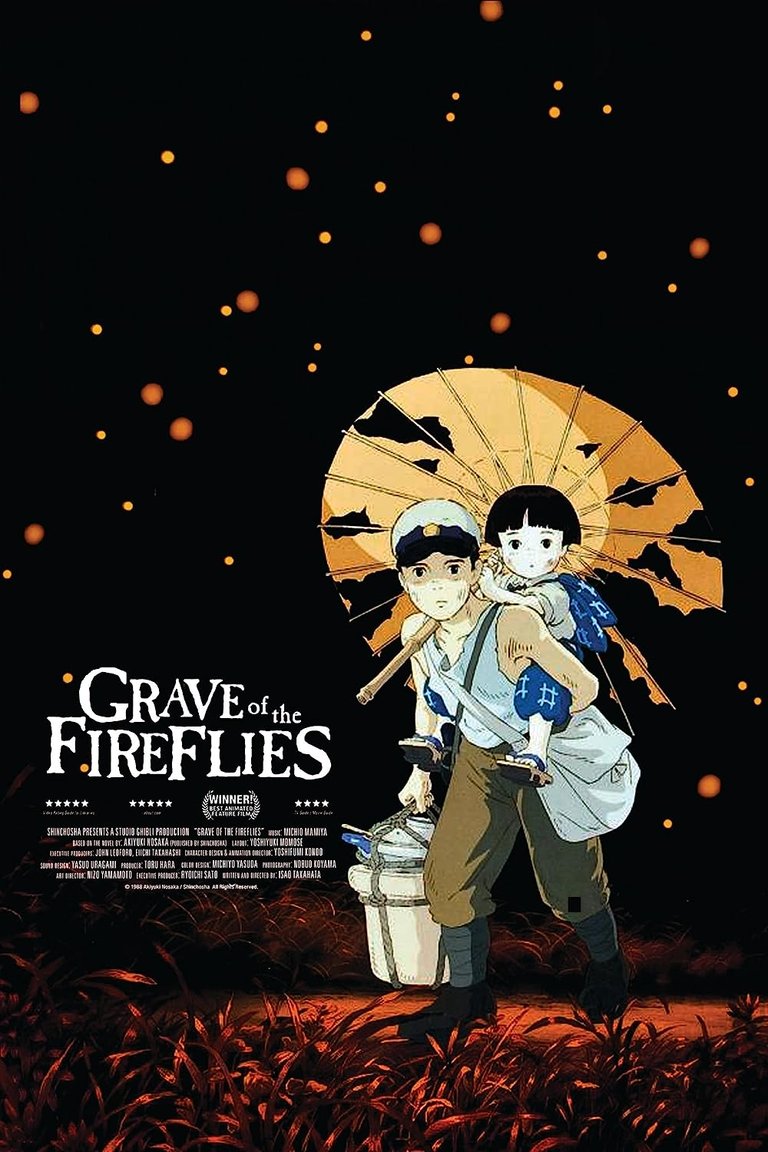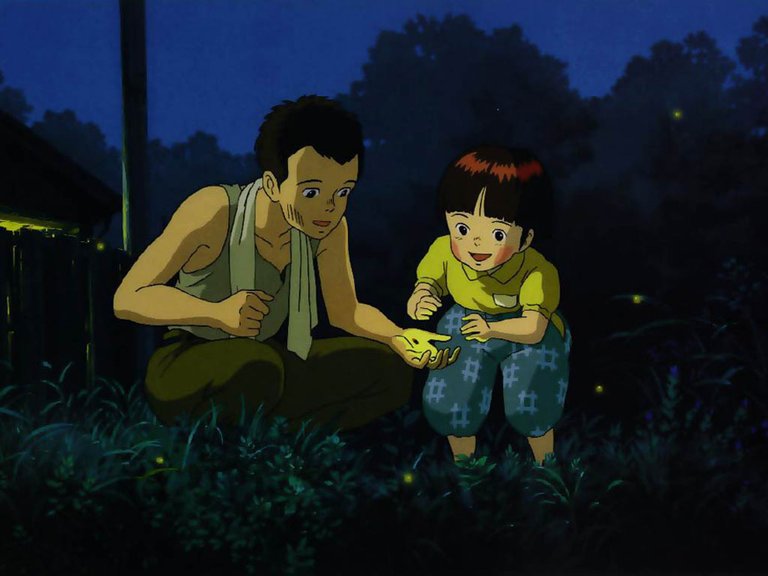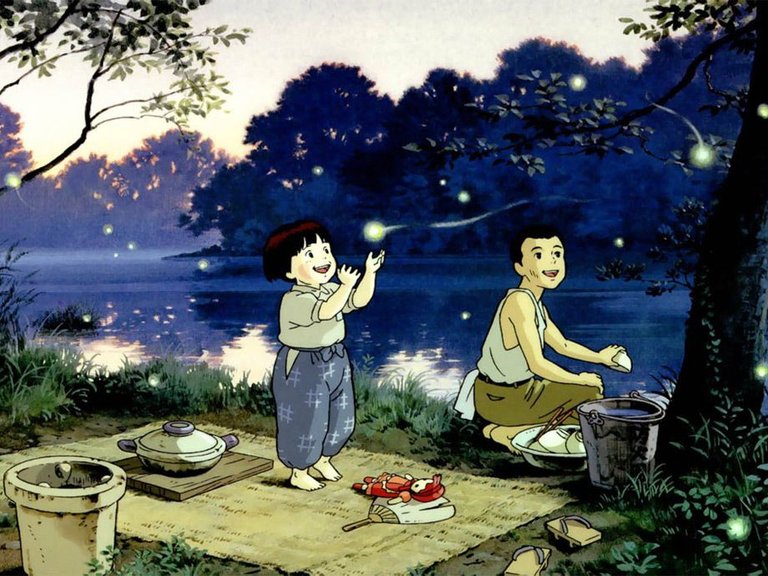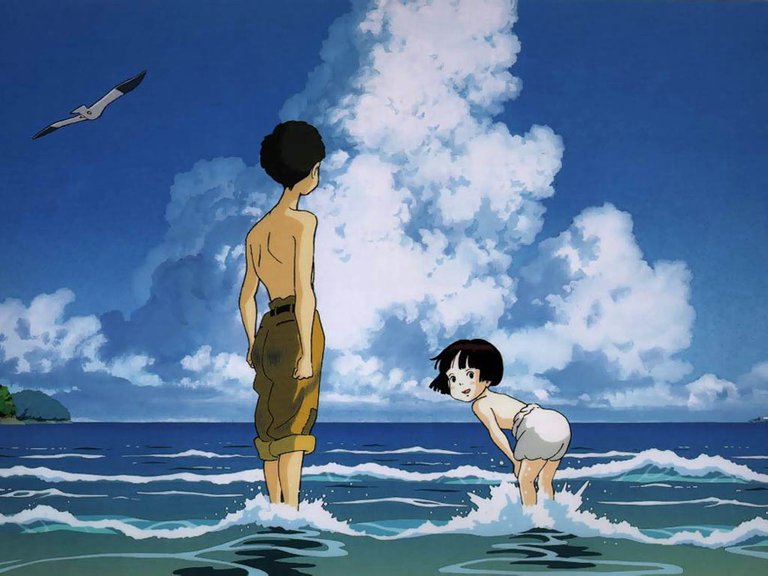Grave of the Fireflies: A sensitizing film [ENG/ESP]
Greetings! Today I come to talk to you about a movie that surely many of you have already seen, another one produced by the excellence of Studio Ghibli and that touches on a rather sensitive subject.
¡Saludos! Hoy vengo a hablarles de una película que seguramente muchos ya han visto, otra producida por la excelencia del Studio Ghibli y que toca un tema bastante sensible.
Grave of the Fireflies is a Japanese animated film directed by Isao Takahata and produced by Studio Ghibli, based on the novel of the same name by Akiyuki Nosaka. It was released in 1988 and is considered one of the masterpieces of animated cinema and one of the most moving and heartbreaking films about war.
The film tells the story of Seita and Setsuko, two siblings living in Kobe, Japan, during the last months of World War II. Their father is a naval officer on the front lines and their mother is killed in a bombing raid. The children are left alone and have to survive in the midst of misery, hunger, disease and the indifference of adults.
La tumba de las luciérnagas es una película de animación japonesa dirigida por Isao Takahata y producida por Studio Ghibli, basada en la novela homónima de Akiyuki Nosaka. Se estrenó en 1988 y se considera una de las obras maestras del cine de animación y una de las películas más conmovedoras y desgarradoras sobre la guerra.
La película narra la historia de Seita y Setsuko, dos hermanos que viven en Kobe, Japón, durante los últimos meses de la Segunda Guerra Mundial. Su padre es un oficial de la marina que está en el frente y su madre muere en un bombardeo. Los niños se quedan solos y tienen que sobrevivir en medio de la miseria, el hambre, la enfermedad y la indiferencia de los adultos.
The film is not a simple chronicle of the horrors of war, but a profound reflection on the value of life, brotherly love, lost innocence and responsibility. The film shows the contrast between cruelty and beauty, between light and darkness, between fireflies and bombs. Fireflies are a recurring symbol in the film, representing hope, memory and the spirit of children.
The film has a realistic and sober style, avoiding sentimentality and melodrama. The director uses a non-linear narrative, alternating the present and the past, creating a flashback effect that increases the emotional impact. The animation is of high quality, with careful detail in the settings, characters and movements. The music is subtle and emotional, composed by Michio Mamiya.
La película no es una simple crónica de los horrores de la guerra, sino una profunda reflexión sobre el valor de la vida, el amor fraternal, la inocencia perdida y la responsabilidad. La película muestra el contraste entre la crueldad y la belleza, entre la luz y la oscuridad, entre las luciérnagas y las bombas. Las luciérnagas son un símbolo recurrente en la película, que representan la esperanza, el recuerdo y el espíritu de los niños.
La película tiene un estilo realista y sobrio, que evita el sentimentalismo y el melodrama. El director utiliza una narrativa no lineal, que alterna el presente y el pasado, creando un efecto de flashback que aumenta el impacto emocional. La animación es de gran calidad, con un cuidado detalle en los escenarios, los personajes y los movimientos. La música es sutil y emotiva, compuesta por Michio Mamiya.
The film has received numerous awards and accolades, both in Japan and around the world. It has been praised by specialized critics and by the general public, who have been impressed by its dramatic force and its humanist message. The film has been compared to other masterpieces of war cinema, such as Schindler's List and The Pianist. It has also been considered an influence on other animation directors, such as Hayao Miyazaki and Makoto Shinkai.
La película ha recibido numerosos premios y reconocimientos, tanto en Japón como en el resto del mundo. Ha sido alabada por la crítica especializada y por el público general, que ha quedado impresionado por su fuerza dramática y su mensaje humanista. La película ha sido comparada con otras obras maestras del cine bélico, como La lista de Schindler o El pianista. También ha sido considerada como una influencia para otros directores de animación, como Hayao Miyazaki o Makoto Shinkai.
Grave of the Fireflies is a film that leaves no one indifferent, that moves and makes you think. It is a work of art that transcends the genre of animation and becomes a universal work. It is a film that deserves to be seen and remembered. Let me know what you thought if you have already seen it, and if not, I recommend you to see it, although it may touch your most sensitive fibers. Thanks for reading and see you later in another post ❤️
La tumba de las luciérnagas es una película que no deja indiferente a nadie, que conmueve y hace reflexionar. Es una obra de arte que trasciende el género de la animación y se convierte en una obra universal. Es una película que merece ser vista y recordada. Cuéntame qué te pareció si ya la viste, y si no, te recomiendo que la veas, aunque pueda que toque tus fibras más sensibles. Gracias por leerme y nos vemos luego en otro post ❤️
Sources:
Grave of the Fireflies
Grave of the Fireflies (1988) - FilmAffinity
Fuentes:
La tumba de las luciérnagas
La tumba de las luciérnagas (1988) - FilmAffinity
Fact that has nothing to do with the post, but for things of life, when I was writing the post, only sad songs were playing in my playlist, I'm tears 🥲
Dato que no tiene nada que ver con el post, pero por cosas de la vida, cuando estaba redactando el post, sonaron sólo canciones tristes en mi playlist, soy lágrimas 🥲

Text translated into English by DeepL
Texto traducido al inglés por DeepL




This film is a work of art both in script and animation, it is from 1988 but has aged very well. I remember when I saw it I felt very sad because I could understand more clearly the horrors of war, but I could also understand more deeply the values and love of family.
On the other hand, I want to invite you to visit the posts of other users, remember that interactions are fundamental for us to continue growing.
Thanks for sharing! See you soon!
Ésta es una de las películas que he visto más de una vez y cada vez que la veo me sigo sintiendo cómo la primera vez, es bastante fuerte la historia
¡Muchas gracias por leer!
Excelente publicación y excelente reseña de la peli, soy fan de las películas de los Estudios Ghibli, no he visto esa peli en particular aunque si que me han hablado mucho de ella, debería buscarla, gracias por compartir. De mi parte te recomiendo "Your Name" y "Suzume" de Makoto Shinkai, me gustan también mucho sus pelis
Muchas gracias por leer mi post, te recomiendo ésta película, aunque debo advertirte que es bastante triste... y muchas gracias por la recomendación, debo confesar que ya he visto ésas dos películas, pero con gusto las volvería a ver
Por nada, es agradable encontrar este tipo de recomendaciones, no te preocupes, prepararé los pañuelos jajajaj
Congratulations @ibet! You have completed the following achievement on the Hive blockchain And have been rewarded with New badge(s)
Your next target is to reach 3500 upvotes.
You can view your badges on your board and compare yourself to others in the Ranking
If you no longer want to receive notifications, reply to this comment with the word
STOPCheck out our last posts:
I know this film is really an incredible one but to be honest, I have not watched it yet. Or maybe I did, but only forgot about it.. But surely, Ghibli never fails!
Thanks for reading! And it's true, Ghibli never fails!
When I watched this film 🎬 at the very first time, I thought that it was a somber 😭 film about two poor children who tried to live without help from adults during the war. And, I thought that there were many of children who were like them because of the war....
But, when I watched it second time, I realized that he couldn't communicate well with his aunt and his relatives because of his mere childish pride which he thought he could live without them. Also, he failed to ask for help although his parents saved much money in their bank account which he could withdraw.
This film gives me lots of insights not just because it's a sad story, but also I felt that it made me think 🤔 💭 how we have to save children and how children communicate.
Do you know that in the reality, the writer of this story Akihiko Nosaka, he actually asked for help and he survived and he couldn't save his little sister due to his childish pride he had (in the end, he couldn't ask for help in the reality as well, which made him regret profoundly)....then he decided to write this story.
It's up to us how we understand this story, but it's so nice that you've introduced this story to Hivers 😄👏😄👏 This is one of my favorite pieces by Isao Takahata 😉
🥦 !PGM !HUG 🥦
I sent 1.0 HUG on behalf of @mizuosemla.
(1/3)
BUY AND STAKE THE PGM TO SEND A LOT OF TOKENS!
The tokens that the command sends are: 0.1 PGM-0.1 LVL-0.1 THGAMING-0.05 DEC-15 SBT-1 STARBITS-[0.00000001 BTC (SWAP.BTC) only if you have 2500 PGM in stake or more ]
5000 PGM IN STAKE = 2x rewards!
Discord
Support the curation account @ pgm-curator with a delegation 10 HP - 50 HP - 100 HP - 500 HP - 1000 HP
Get potential votes from @ pgm-curator by paying in PGM, here is a guide
I'm a bot, if you want a hand ask @ zottone444
Thank you very much for leaving your comment, the truth is you are right and I didn't leave it in the post so as not to give spoilers. I think it's a bit of everything, Seita's stubbornness, the aunt was quite cruel in how she said things, especially to poor Setsuko who was just a little girl, also the indifference of many adults. I think the aunt did behave a bit badly, come on, she didn't even give them good food and Seita's mother's clothes had been sold. I've seen a lot of discussion about that situation, but I really don't know what to think other than that there were several unfavorable situations, if I think Seita didn't know how to ask for help and thought she could do it alone. Anyway, I think it's a movie that teaches us a harsh reality.
Yeah, I agree. The aunt is pretty harsh, but I believe that people had to be ego-centric in a way to survive in the wartime. Well, Seita didn't do anything while others were working. That sucks. The saddest part of the film is that the most innocent Setsuko died because of the cruel side of humanity and the war made changed lots of people including the aunt and Seita. What a masterpiece by Isao Takahata 😃👏👏
🥦 !PIZZA !HUG 🥦
I sent 1.0 HUG on behalf of @mizuosemla.
(3/3)
The most interesting thing about this story for me, is that not everything is "black" or "white", there are nuances, given the context and the situation that was lived, I understand that the aunt was like that, maybe it was not the best way to act, but, many people at that time had to be selfish. Seita was quite impulsive, but I don't crucify him because he was only 14 years old, we can't expect him to act like an adult. It's definitely a work worth analyzing and that's what I like most about it.
Indeed!! Indeed!!! You would definitely get an A+ in Intercultural Communication in Anime 😃👏👏
🥦 !PIZZA 🥦
$PIZZA slices delivered:
@mizuosemla(4/10) tipped @ibet (x2)
This movie broke my heart because I think that these situations were lived and are still lived in those innocent people (including many children) who lose everything because of the war. They are the most attacked and they only came to the world to be happy and live, very sad indeed.
It is a work that will never be forgotten and gratifying that it comes from Studio Ghibli, one of the best.
It is really worth seeing this jewel of Japanese cinema, HOPE is the last thing to be lost.
Unfortunately for these brothers, things did not turn out well, but that's life, and even more so in the context of war.
Thanks for reading
se ve interesante, me emociona el verla 😃